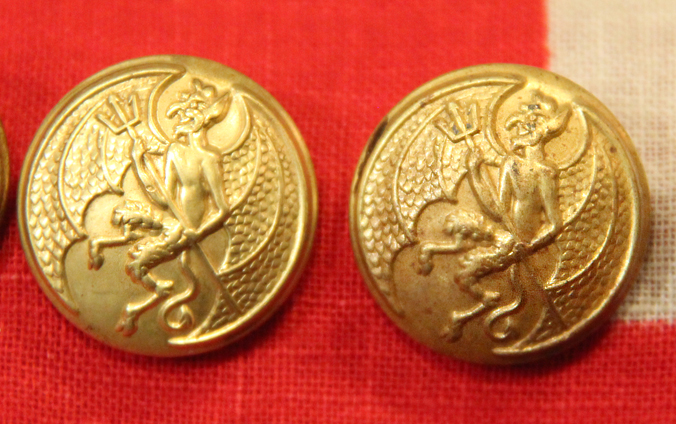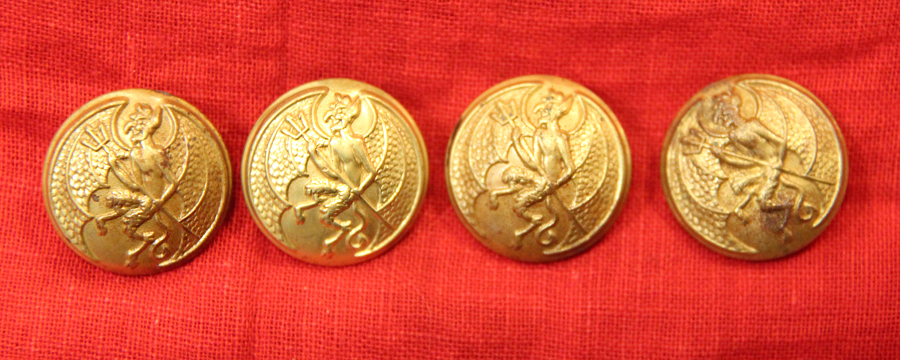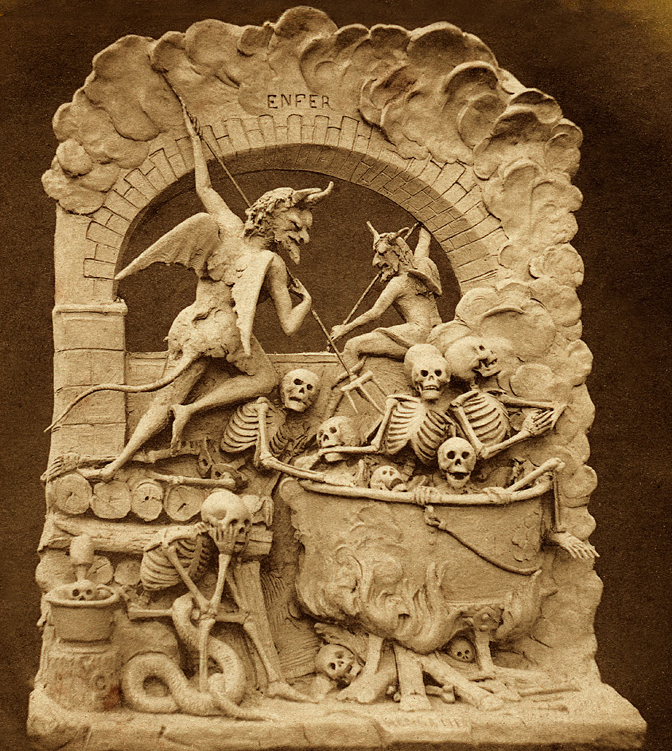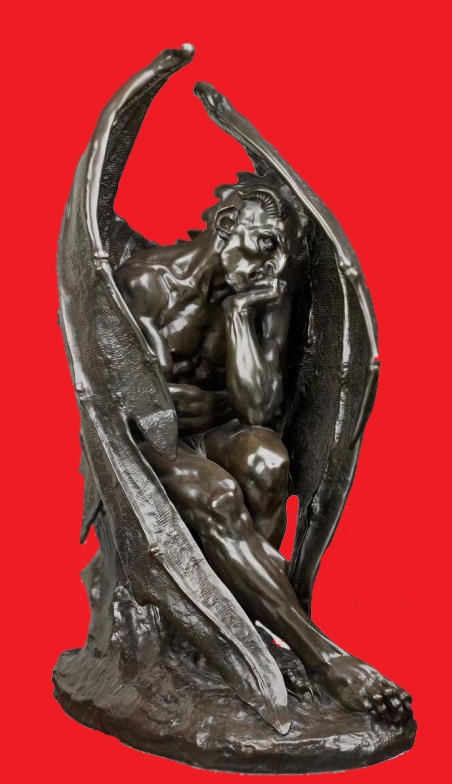Superb Complete Set of 'Satanic' Style Buttons of The Inns of Court Regt. AKA The Devil's Own Regiment As Named By King George IIIrd
AKA 'The Devil's Own'. So named by King George IIIrd himself, after his exclamation when informed they were a regiment of all lawyers.
'What! What! 'exclaimed the King, 'all lawyers!, all lawyers!, Call them the Devil's Own,
call them the Devil's Own!"
"And the Devil's Own they were called accordingly.".
One of their most famed member of the regiment was William Pitt The Younger.
In original gilded brass, with its gilding still in super condition, by Hammond & Co. Newcastle. Four main buttons and six sleeve buttons. A delightful set of original Satanic repousse buttons of the Devil's Own Regiment. The Devil played a vital role in Victorian popular belief. He was a multifaceted figure who could be humorous or terrifying, depending on the occasion. While he struggled for space with an array of supernatural figures, the Devil managed to maintain a presence in a wide variety of supernatural narratives and beliefs. Known by a variety of names Satan, Lucifer, Mephistopheles the Devil remains one of the most intriguing and ubiquitous figures in western literature, with such literary luminaries as Dante, Milton, and Goethe finding in him the perfect personification of the human impulse toward evil. Since the advent of the Bible, the Devil has existed as the quintessential adversary, and the ultimate antithesis to goodness and morality. In the Medieval era, the Devil evolved from a relatively minor role in Holy Scripture to a dominant figure in the didactic mystery and morality plays of the day. During the Reformation and Renaissance, Luciferian figures continued to be abstracted and allegorized in literature, that is until the publication of John Milton's Paradise Lost in 1667. In the poem Milton drew a dynamic and supremely defiant Satan, whom subsequent interpreters would sometimes view as the epic's subversive protagonist. Meanwhile, in the eighteenth-century, the rising tide of Enlightenment rationalism prompted a decline in literary representations of Satan, with many considering the Devil as an inappropriate subject even of mockery or satire. All of this began to change by the end of the century and the new vogue of the Gothic novel in England. Writers, typified by Matthew Gregory Lewis in his popular Ambrosio the Monk (1796), seized upon Satan as a principal source of supernatural horror, creating a mania for spine-tingling terror among readers. One larger button has received a small ding at some time and now very slightly less domed. They would look beautiful bespoke framed. The buttons were used for the Inns of Court Regiment known as The Devils Own. Early history
The Inns of Court Officers' Training Corps Memorial at Berkhamsted
Back in the 14th to 16th centuries, judges were called upon to perform functions that, in modern times, would hardly be considered to come within judicial office. Accordingly, members of the Inns found themselves called to fight in the wars of King John or against Robert the Bruce. One such defence of Medieval London was organised in 1381 against Wat Tyler, during the Peasants' Revolt (when the Chief Justice was killed). In 1467, the Chief Justice of the Exchequer, then Recorder of the city of London, was instrumental in defeating a Lancastrian attack on the city of London. Further accounts, such as Henry Machyn's diary (1554), tell of more localised defences when "On the xij day of Juin was a gret fray be-twyn the Lord Warden's servants of Kent and the Ines of Greys Inn and Lynkolne(s) Inn, and some sleyn and hurt."
The Bloomsbury and Inns of Court Volunteers was reformed in 1797 during the Napoleonic Wars. It was shortly afterwards that the regiment gained its enduring nickname. During a review by King George III in Hyde Park in 1803, the King used his dislike for lawyers, particularly ones carrying arms, to name the massed ranks of the Law Association as "The Devil's Own". "It is understood that the King was in high health and excellent spirits at the time. When the 'Temple companies' had defiled before him, his Majesty enquired of Lord David Erskine, who commanded them, as lieutenant colonel, what was the composition of that corps? 'They are all lawyers, Sire,' said Erskine. 'What! What! 'exclaimed the King, 'all lawyers! All lawyers! Call them the Devil's Own, call them the Devil's Own!" "And the Devil's Own they were called accordingly."
The Bloomsbury and Inns of Court Volunteers was reformed in 1797 during the Napoleonic Wars. It was shortly afterwards that the regiment gained its enduring nickname. During a review by King George III in Hyde Park in 1803, the King used his dislike for lawyers particularly ones carrying arms to name the massed ranks of the Law Association as "The Devil's Own". "It is understood that the King was in high health and excellent spirits at the time. When the 'Temple companies' had defiled before him, his Majesty enquired of Lord David Erskine, who commanded them, as lieutenant colonel, what was the composition of that corps? 'They are all lawyers, Sire,' said Erskine. 'What! What! 'exclaimed the King, 'all lawyers All lawyers Call them the Devil's Own, call them the Devil's Own!" "And the Devil's Own they were called accordingly."
The first organised body formed by the Inns of Court appears to have been in Holborn, London, in 1584. At that time, associations known as trained bands were formed to assist in the defence of the country from the Spanish Armada. The deed itself, associating the members of Lincoln's Inn, is still in existence, having been preserved by its first signatory, Thomas Egerton, then Solicitor-General, and afterwards Lord Chancellor.
The history is ambiguous thereafter, although many lawyers were known to join the Royalists, and their clerks the Parliamentarians, during the English Civil War. Certainly, members of The Inns were called out against the Jacobite rising of 1745 and the Gordon riots of 1780. Indeed, future prime minister William Pitt the Younger served in the Lincoln's Inn Company. The regiment thus continued from thence on, in fact with some elements of distinction, right into WW2, and thereafter as yeomanry. The regiment's battle honours were as follows:
South Africa 1900-01
The Second World War:
Normandy Landing, Caen, Bourgu, Bus Ridge, Cagny, Catheolles, Amiens 1944, Antwerp, Hechtel, Rhine, Leese, Aller, North-West Europe 1944-45
Code: 22255






